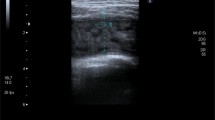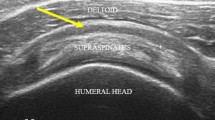Abstract
A spectrum of pathologies can cause clicking, popping or snapping of the shoulder joint. These can lead to a patient seeking attention in clinical practice due to pain, discomfort and impact on activities of daily living. Traditionally these can originate from pathologies which involve biceps tendon, tears of the rotator cuff or the glenoid labrum, articular cartilage or due to loose bodies and scapulothoracic joint dysfunction [Guillin et al. in Br J Radiol 85:1343–1353, 2012; Vidoni et al. in Indian J Musculoskelet Radiol 4:61–69, 2022]. Subacromial subdeltoid (SASD) bursitis is a well-described entity and one of the commonest causes of shoulder pain. We present SASD bursitis as an unusual cause of clicking/snapping in the shoulder without associated pain in a healthy young male. The clinical presentation, diagnostic strategy with complementary imaging and the role of interventional radiology in its effective management is highlighted to support clinicians faced with a diagnostic dilemma.
Similar content being viewed by others
Avoid common mistakes on your manuscript.
Introduction
The shoulder joint is a ball and socket synovial articulation stabilised by dynamic soft tissue and osseous-ligamentous static stabilizers around it. The soft tissue complex involve an integral combination of the rotator cuff group of muscles (the supraspinatus, infraspinatus, teres minor and subscapularis), their tendons, glenohumeral ligaments and the protective components of various bursae around the shoulder.
Peri-articular bursae are small fluid-filled sacs that reduce friction between articular components and surrounding tissues such as tendons or muscles. Around the shoulder joint, six bursae and bursal spaces namely: Subacromial-subdeltoid (SASD) bursa; Subscapular bursal recess; Sub coracoid bursa; Coracoclavicular bursa; Supra-acromial bursa and medial extension of subacromial-subdeltoid bursa have been described [3]. Sometimes these bursal tissue do get inflamed with or without associated gleno-humeral or rotator cuff pathologies, lead to pain and present as a common cause of shoulder pain [4].
Here-in we present a young, healthy male with symptomatic clicking/snapping in the shoulder due SASD bursitis leading him to seek medical attention. Role of static and dynamic Ultrasonography (USS) is described to aid clinical diagnosis [5].
Case report
A young, right-hand dominant man in his early 20’s presented with 2 months insidious onset of painless clicking of right shoulder. There was no history of trauma and no significant past medical history was noted. He did not play any sports, profession or amateur.
On examination, the shoulder contour was well maintained with no wasting detectable in the peri-scapular region.
There was no focal area of tenderness which could be elicited at the osteoarticular landmarks around the right shoulder, acromio-clavicular or the sternoclavicular joint. The long head of biceps could be well palpated in the bicipital groove.
The right shoulder revealed congruent, full range of movements though with a palpable, painless click at 80 degrees of lateral abduction. The rotator cuff was clinically intact.
The Apprehension sign was negative with no features of instability. The arc of shoulder movement was painless apart from the clicking with a negative Hawkins-Kennedy test for sub-acromial impingement. He was neurovascularly intact.
An Ultrasound (USG—Phillips iU 22) was organised to further evaluate the painless clicking. The biceps tendon was normally located in the bicipital groove without subluxation or dislocation on dynamic examination. Subscapularis, supraspinatus and infraspinatus were intact without any tear or tendinopathy. Acromioclavicular joint was normal and there was no gross abnormality of the scapulothoracic joint on USG. There was small amount of fluid in the SASD bursa with mixed (predominantly low) echogenicity (Fig. 1).
On dynamic active abduction the fluid in the SASD bursa and synoivial thickening of the bursa was noted to sublux anteriorly with a palpable painless click at 80 degrees of abduction which reduced when abducted arm was lowered below 80° (Fig. 2, Video).
This could be demonstrated consistently during every episode of abduction.
The findings of static and dynamic USG imaging was reassuring in ruling out a significant impingement lesion due to the surrounding soft tissue structures around the shoulder joint specifically the rotator cuff complex or other pathologies such as calcific tendinopathy.
He was managed with reassurance, supervised physiotherapy regimen, activity modification and anti-inflammatory non-steroidal medication (topical and oral) with gradual improvement over a period of 6 months.
Discussion
A ‘Clicking’ shoulder is not uncommon in a shoulder clinic and can be due to a plethora of pathologies of either intra-articular (glenohumeral joint) or extra-articular origin [6, 7].These can be often mentioned as ‘snapping’ and can be either painful or painless clicking.
Painless clicking is often bilateral and attributed to sudden change in pressure within the joints or bursal cavities, though the exact cause is unknown. On the other hand, painful clicking is usually associated with an underlying pathology.
In the gleno-humeral region, there are a number of commonly recognised areas of painful clicking from the shoulder. These include:
-
1.
Glenohumeral joint
-
2.
Subacromial bursa
-
3.
Long head of biceps tendon
-
4.
Scapulo-thoracic articulation
-
5.
Acromioclavicular joint
-
6.
Subcoracoid space
Intra-articular causes are predominantly due to sequela of glenohumeral joint instability [8]. Extra-articular causes can involve the scapulothoracic joint which include exostosis, soft tissue sarcoma, scapulothoracic bursitis, elastofibroma dorsi, anteriorly curved scapular border and Luschka’s tubercle [1, 11, 12]. The other extra-articular causes can be due snapping of the long head of biceps, subacromial bony prominence/spur snapping with supraspinatus tendon, aberrant pectoralis minor tendon, or impingement of subacromial bursitis and coracoid process. [1, 2, 9, 10]
Subacromial subdeltoid (SASD) bursitis and subacromial impingement are the most common causes of shoulder pain. On dynamic abduction of the shoulder there can be narrowing of the subacromial joint space if there is no inferior displacement of humeral head, prominent inferior osteophytes of acromioclavicular joint, lateral downsloping of acromion and SASD bursitis. [3, 10] This can be evaluated at the lateral end of the clavicle or in relation to the coracoacromial arch. In our case there was focal SASD bursitis which was lateral to the end of acromion upto 80° of abduction. Beyond this level we hypothesize that due to narrowing of the subacromial joint space the focal SASD bursitis subluxed anteriorly to allow abduction beyond 80°. This was probably due to the fact that SASD bursitis was focal rather than diffuse.
The management of clicking shoulder depends on addressing the underlying cause and most of the patients can be managed conservatively. These include reassurance, rest, activity modification, physiotherapy and NSAIDs for pain relief. A subset of patients may benefit from intra-articular or bursal steroid injections. Surgery is usually not indicated for treatment of clicking unless there are other clinical concerns with failure of conservative measures.
To conclude, SASD bursitis, although a common cause of shoulder pain, has never been reported in literature as a cause of painless clicking. One needs to consider this pathology in the differential during evaluation of snapping shoulder.
Data availability statement
The data that support the findings of this study are available from the corresponding author, [RB], upon reasonable request.
References
Guillin R, Marchand AJ, Roux A et al (2012) Imaging of snapping phenomena. Br J Radiol 85(1018):1343–1353. https://doi.org/10.1259/bjr/52009417
Vidoni A, Davies M, James S, Botchu R (2022) Relevance of Scapulothoracic joint assessment for unknown shoulder pain. Indian J Musculoskelet Radiol 4:61–69
Chang LR, Anand P, Varacallo M (2022) Anatomy, shoulder and upper limb, glenohumeral joint. StatPearls. StatPearls Publishing, Treasure Island (PMID: 30725703)
LeNoir JL (1986) Subacromial-subdeltoid bursitis of the shoulder. Orthop Rev 15(11):730–732 (PMID: 3453917)
Ricci V, Chang KV, Güvener O, Mezian K, Kara M, Leblebicioğlu G, Stecco C, Pirri C, Ata AM, Dughbaj M, Jain NB, Özçakar L (2022) EURO-MUSCULUS/USPRM dynamic ultrasound protocols for shoulder. Am J Phys Med Rehabil 101(3):e29–e36
Ricci V, Galletti S, Chang KV, Özçakar L (2020) Ultrasound imaging and guidance in the management of adhesive bursopathy of the shoulder: a video demonstration. J Ultrasound Med 39(3):633–635
Madani H, Ather S, Giggens R (2022) Snapping shoulder secondary to subluxation of an accessory coracobrachialis. Cureus 12(5):e7967. https://doi.org/10.7759/cureus.7967 (PMID: 32523824; PMCID: PMC7273437)
Funk L (2022) Painful clicking, snapping and popping of the shoulder. Available from: https://www.shoulderdoc.co.uk/article/1624 Cited 3 Nov 2022
Park J, Chai JW, Kim DH, Cha SW (2018) Dynamic ultrasonography of the shoulder. Ultrasonography 37(3):190–199
Daghir AA, Sookur PA, Shah S, Watson M (2012) Dynamic ultrasound of the subacromial-subdeltoid bursa in patients with shoulder impingement: a comparison with normal volunteers. Skeletal Radiol 41(9):1047–1053. https://doi.org/10.1007/s00256-011-1295-z (Epub 2011 Oct 14 PMID: 21997670)
Sans N, Jarlaud T, Sarrouy P (1999) Snapping scapula: the value of 3D imaging. J Radiol 80:379–381
Majo J, Gracia I, Doncel A (2001) Elastofibroma dorsi as a cause of shoulder pain or snapping scapula. Clin Orthop Relat Res 388:200–204
Funding
No funding to declare.
Author information
Authors and Affiliations
Corresponding author
Ethics declarations
Conflict of interest
No conflict of interest.
Informed consent
Informed patient consent was obtained from the patient for the Figures and the Video.
Additional information
Publisher's Note
Springer Nature remains neutral with regard to jurisdictional claims in published maps and institutional affiliations.
Supplementary Information
Below is the link to the electronic supplementary material.
Video of shoulder demonstrating clicking due to subluxating SASD bursitis (MOV 42457 kb)
Rights and permissions
Springer Nature or its licensor (e.g. a society or other partner) holds exclusive rights to this article under a publishing agreement with the author(s) or other rightsholder(s); author self-archiving of the accepted manuscript version of this article is solely governed by the terms of such publishing agreement and applicable law.
About this article
Cite this article
Nischal, N., Iyengar, K.P. & Botchu, R. Clicking shoulder due to snapping Subacromial subdeltoid (SASD) bursitis: a case report of an unusual presentation in clinical practice with imaging features. J Ultrasound (2022). https://doi.org/10.1007/s40477-022-00758-0
Received:
Accepted:
Published:
DOI: https://doi.org/10.1007/s40477-022-00758-0






